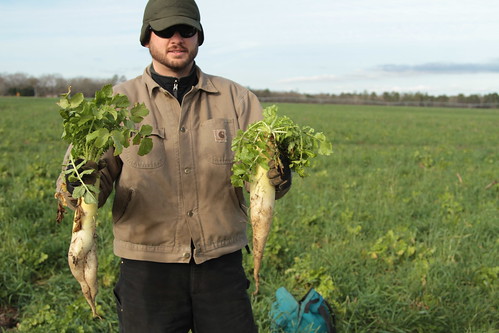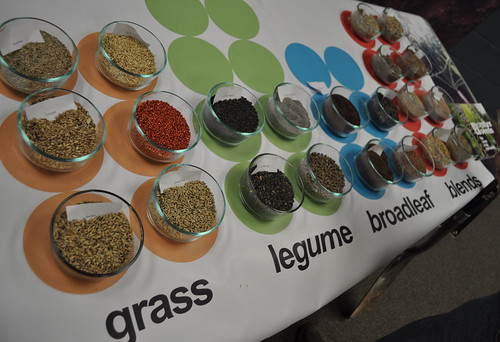
Jason Carter is one of the five South Carolina farmers participating in a field study funded through a Conservation Innovation Grant. His tillage radishes are part of his multispecies cover crop mix. NRCS photo.
Nearly 100 farmers recently gathered in Dillon County, S.C. to see why some farmers are raving about the benefits of cover crops. A few groups hosted a field day to illustrate first-year findings resulting from demonstrations made possible through a USDA Conservation Innovation Grant.
USDA’s Natural Resources Conservation Service awarded the three-year grant to the soil and water conservation districts in Richland, Dillon and Marlboro counties and the Earth Sciences and Resources Institute at the University of South Carolina (USC).
The project involves five farmers in three counties across South Carolina who agreed to plant multispecies cover crops each fall, vary the amount of nitrogen they apply each spring and record their cash crop yields.
The nutrient benefit that the cover crops provide can be measured by looking at soil respiration, or 24-hour carbon dioxide production, using a special test called the Haney-Brinton test.
Science shows that soil respiration is closely related to the amount of nitrogen that will be released for plant growth. In the study, the participating farmers will apply the traditional recommended rate of commercial nitrogen to one half of the test field, and based on the Haney-Brinton quantification, a lesser amount to the other half.
“We expect to see little to no difference in yield between the regular nitrogen and lower nitrogen applications,” said Buz Kloot, a USC professor.
Kloot says as the costs of inputs rise, farmers are becoming more interested in the idea that increased soil health can provide real benefits that include increased soil moisture, better crop yields, lower weed pressure, reduced inputs and lower costs.
“It was really gratifying to see a room full of growers seriously interested in soil health and in the outcomes of our field demonstrations,” said Chanda Cooper, the education coordinator for the Richland Soil and Water Conservation District.
Cooper said the next step of the project is conducting spring soil respiration tests, which will be used to make recommendations for commercial nitrogen reduction.
“The five farmers participating in this project are innovators and spokesmen for soil health and conservation,” she said. “Their enthusiasm and commitment to the work, and their testimony to their peers, is more meaningful than any set of results that a test can generate.”
The grant is enabling conservation partners in South Carolina to seize the opportunity to be leaders in the soil health movement, and judging from the enthusiasm at the demonstration, farmers are realizing the critical link between soil organic matter, soil health and financial savings.
Conservation Innovation Grants are awarded to entities across the nation to develop and demonstrate cutting-edge ideas to accelerate private lands conservation. Learn more about these grant opportunities.

The grant is studying the impacts of different types of cover crops. NRCS photo.
No comments:
Post a Comment
Note: Only a member of this blog may post a comment.